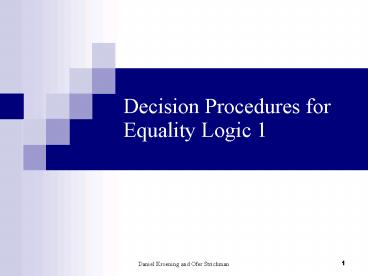Decision Procedures for Equality Logic 1 - PowerPoint PPT Presentation
Title:
Decision Procedures for Equality Logic 1
Description:
Output: such that is valid iff UF is valid. 1. Assign indices to the UF-instances. ... FCE ) flatE is valid iff UF is valid. Validity check of ... – PowerPoint PPT presentation
Number of Views:20
Avg rating:3.0/5.0
Title: Decision Procedures for Equality Logic 1
1
Decision Procedures for Equality Logic 1
2
Equality logic
- Def. An equality logic formula is defined by the
following grammarformula formula formula
formula atomatom term termterm
identifier constantwhere the
identifiers are variables over a single infinite
domain like the reals or integers. Constants are
elements from the same domain as identifiers.
3
Complexity
- Equality logic and propositional logic are both
NP-complete. - Thus they model the same decision problems.
- Why to study both?- convenience of modeling-
efficiency - Extensions different domains, Boolean variables
4
Basic assumptions and notations
- Input formulas are in NNF
- Input formulas are checked for satisfiability
- Equality formula ?E
5
Removing constantsA simplification
- Thm. Given an equality logic formula ?E, there is
an algorithm that generates an equisatisfiable
formula ?E' without constants, in polynomial
time. - Algorithm Input An equality logic formula ?E
with constants c1,...,cnOutput An equality
logic formula ?E' such that ?E and ?E' are
equisatisfiable and ?E' has no constants.
6
Removing constantsA simplification
- 1. ?E' ?E2. In ?E', replace each constant
ci, 1in, with a new variable Cci .3.
For each pair of constants ci, cj such that
1iltjn, add the constraint Cci ?Ccj to
?E' . - In the following we assume that the input
equality formulas do not have constants.
7
Uninterpreted functions
- Def. An equality logic formula with uninterpreted
functions and uninterpreted predicates is defined
by the following grammarformula formula
formula formula (formula)
atomatom term term
predicate-symbol(list of terms)term
identifier function-symbol(list of terms)? - Example F(x)F(G(x))
- Congruence xG(x) ) F(x) F(G(x))
8
Usage of uninterpreted functions
- Replacing functions by uninterpreted functions in
a given formula is a common technique to make
reasoning easier. - Makes the formula weaker ?UF ) ???
- Ignore the semantics of the function, but
- Functional congruence Instances of the same
function return the same value for equal
arguments.
9
From uninterpreted functions to equality logic
- Two possible reductions- Ackermann's
reduction- Bryant's reduction - Ackermann's reductionGiven an input formula
?UF, add explicit constraints for functional
congruence and transform the formula to an
equality logic formula ?? of the form
??????FCE ) flatEwhere FCE is a
conjunction of functional-consistency
constraints, and flatE is a flattening of ?UF.
10
- Algoritm Ackermann's reductionInput ?UF with m
instances of an uninterpreted function
F Output ???such that ???is valid iff ?UF is
valid1. Assign indices to the UF-instances.2.
flatE T(?UF) where T replaces each Fi by a fresh
fi3. FCE i1..m-1 ji1..m
(T(arg(Fi)) T(arg(Fj))) ) fifj4. Return
??? FCE ) flatE
11
Ackermann's reductionExample
- (x1 ? x2) _ (F(x1) F(x2)) _ (F(x1) ? F(x3))?
- flatE (x1 ? x2) _ (f1 f2) _ (f1 ? f3))?
- FCE (x1x2 ) f1f2) (x1x3 )
f1f3) (x2x3 ) f2f3) - ??? FCE ) flatE
12
Ackermann's reduction validity vs. satisfiability
- ??? FCE ) flatE?is valid iff ?UF is valid
- Validity check of ?UF check ?? for validity or
???for unsatisfiability - What if we want to check satisfiability of ?UF?
- Ackermann's reduction in the above form maintains
validity, not satisfiability! - Solution check satisfiability of ??? FCE
flatE
13
Bryant's reduction
- Case expression Fi case x1xi f1
x2xi
f2
...
true fiwhere xi is the argument
arg(Fi) of Fi for all i - Semantics _j1,...,i (Fi fj (xjxi)
k1,...,j-1 (xk ? xi))?
14
Bryant's reductionAlgorithm
- Input An EUF formula ?UF with m instances of an
uninterpreted function F - Output An EF formula ?? such that ?? is valid
iff ?UF is valid - 1. Assign indices to the uninterpreted-function
instances from subexpressions outwards.2.
Return ?E T (?UF) where T replaces each
Fi(arg(Fi)) by case T (arg(F1))
T (arg(Fi)) f1
... T
(arg(Fi-1)) T (arg(Fi)) fi-1
true
fi
15
Bryant's reduction Example
- int power3_con (int in) int i, out
out in for (i 0 i lt 2 i)
out out in return out - int power3_con_new (int in) return ((in
in) in)
16
Bryant's reduction Example
- int power3_con (int in) int i, out
out in for (i 0 i lt 2 i)
out out in return out - int power3_con_new (int in) return (in
in) in - ?? out0 in out1 out0 in out2 out1
in - ?2 out0_new (in in) in
- ??? ????) out2 out0_new
17
- ? (out0 in out1 out0 in out2
out1 in ??out0_new (in in) in)) out2
out0_new - ?UF (out0 in out1 G(out0,in) out2
G(out1,in) out0_new G(G(in,in),in))) out2
out0_new
18
- ?UF (out0 in out1 G(out0,in) out2
G(out1,in) ?out0_new G(G(in,in),in)) ) out2
out0_new - ?E (out0 in out1 G1 out2 G2
?????out0_new G4 ) out2 out0_newwith G1
g1 G2 case out0out1 inin
g1 true
g2 G3 case
out0in inin g1
case out1in inin g2
true g3
19
- ?UF (out0 in out1 G(out0,in) out2
G(out1,in) ?out0_new G(G(in,in),in)) ) out2
out0_new - ?E (out0 in out1 G1 out2 G2
?????out0_new G4 ) out2 out0_newand
with G4 case out0G3 inin g1
case out1 G3 inin
g2 case in G3
inin g3
true g4
20
EUF where are we now?
- We introduced equality logic and uninterpreted
functions - We showed how to eliminate constants
- We used Ackermann's and Bryant's algorithms to
reduce the validity question in equality logic
with uninterpreted functions to validity
questions in equality logic - Next Decision procedures for equality logic and
uninterpreted functions































